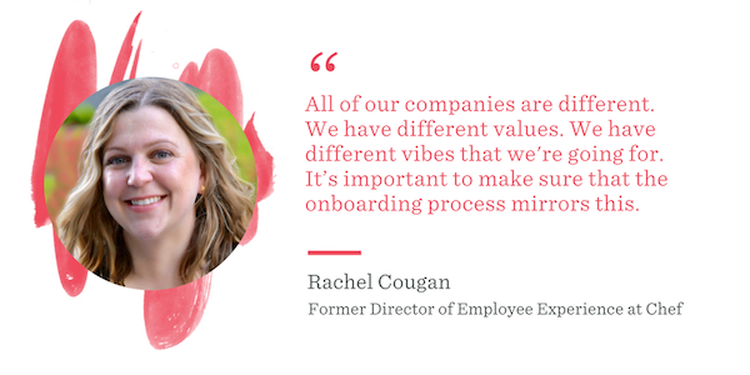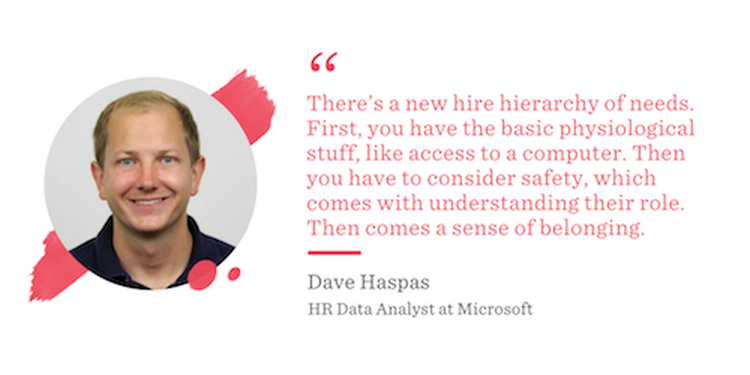
3 ways to improve your onboarding experience using data

Companies are increasingly recognizing the value of people analytics. At a Geekup in Seattle, Culture Amp Senior People Scientist, Fresia Jackson, moderated a panel discussion about how this type of data can be used to create exceptional new hire experiences - specifically when it comes to the onboarding process.
We spoke with three leaders from companies of various sizes and industries:
- Dave Haspas, HR Data Analyst at Microsoft
- Rachel Cougan, VP of People at Textio (formerly, Director of Employee Experience at Chef)
- Matt Kennedy, Director of Talent Management Solutions at Starbucks
While their backgrounds and organizations differ, the panelists identified three common ways they leverage people analytics when it comes to onboarding experiences. We’ll share how they use data to demonstrate the power of onboarding, why they incorporate company values into this process, and how they better meet the needs of new hires.
1. Demonstrate the power of onboarding
First impressions matter. An easy trap for companies to fall into is to establish an onboarding process, then promptly forget about its existence. Dave Haspas, HR Data Analyst at Microsoft, knows firsthand from the data he’s collected that this could be a costly mistake.
“We found that people who have bad onboarding experiences also have higher attrition rates within the first year,” says Dave. “So yes, our data shows that first impressions actually do matter, which is why onboarding is such a big area of focus for us.”
That’s where onboarding surveys come in handy - they can be an effective tool to surface potential weaknesses in the process. These areas for improvement may not be immediately evident to HR leaders, but they play a significant role in employee retention and happiness. This opens up opportunities to iterate and further evolve the program until it’s a truly memorable, positive experience for new hires. Matt Kennedy, Director of Talent Management Solutions at Starbucks, knows that a weak experience can negatively color an employee’s image of the company in the long run.

“I think a bad onboarding experience is a double let down compared to any other negative experience at work,” says Matt. “We need to keep the transition from candidate to employee as seamless as possible and put our best brand foot forward when people are most excited. If we don't, we're allowing that experience to drop off and that’s when you start to see things like attrition and the cost of low morale.”
2. Tailor the process to company values
Every business has a unique set of values, and the onboarding process should be a reflection of them. The first step to accomplish this is to uncover your company’s values. Once you have an understanding of what these values are, it’s important to reinforce them through the onboarding process. Leveraging the power of people analytics can help organizations pinpoint which values are most critical to their employees, and identify which ones may not be coming through as strongly during onboarding. Rachel Cougan, Former Director of Employee Experience at Chef, is a huge advocate of tailoring the onboarding experience to align with the rest of the organization’s culture instead of trying to mimic a different company’s process.
“All of our companies are different, with different values and vibes they’re going for. It’s important to make sure that the onboarding process mirrors this. For instance, Starbucks is lovely. But Chef doesn’t want the Starbucks process. They want to ensure new hires are getting something uniquely Chef when they're being onboarded.”

Why invest so many resources into this single aspect of the new hire experience? Because doing so can ultimately lead to greater business growth and - more importantly - engaged employees. Starbucks, for instance, is a company that has invested a lot of time into figuring out which of its values resonate most with both its employees and customers, and it has developed an onboarding program to match. Its relationship-focused value: “Creating a culture of warmth and belonging, where everyone is welcome,” is particularly important. They’ve invested in nurturing that aspect of their culture with thorough, customized onboarding for retail employees.
“The analytics we've done at Starbucks show time and again that the customer's connection to the barista they interact with is what drives the most return on investments,” says Matt. “We've done the studies and the surveys of customers, and we’ve proven that core relationship is our biggest business driver. And the more stability we have in our stores, the better job we can do to retain great employees.”
3. Better meet the new hire’s needs
During the discussion, Dave brought up an excellent point about how a successful onboarding process should meet the new hire’s hierarchy of needs - from making sure they have the basics covered to cultivating a sense of belonging within the organization. Using people analytics data can help pinpoint what these needs might be, and whether or not they’re being met during the onboarding experience.
“There’s a new hire hierarchy of needs. First, you have the basic physiological stuff, like access to a computer. Then you have to consider safety, which comes with understanding their role. Then comes a sense of belonging. We started to think about what levers we could pull to possibly address some of those areas. That’s when we came up with the concept of onboarding buddies, which we hypothesized might be helpful to addressing various elements of that hierarchy. When the results of the following surveys came back, we found that buddies have a hugely positive impact on the new hire’s onboarding experience - more so than pretty much every other item that we had on the survey.”

Rachel also had a similar experience of using people analytics to gauge where new hire needs were being unmet at Chef. While there, her team noticed a disconnect between the product and the employees.
“Chef has a deeply technical product,” says Rachel. “We found in our surveys and in our interviews with employees that they were struggling to really understand it. That’s why we created a Chef training for non-technical Chefs. If you're not from a technical background, or you just want to learn more about the DevOps space, you can take a five-week online course to quickly get up to speed. Having a basic understanding of what the product does, why it's important, and what pain points Chef’s customers experience before they use the Chef products can really help employees understand why Chef makes a difference in the world.”
It’s clear that onboarding is a crucial part of the new hire experience and can have a huge impact on an employee’s initial feelings of success, fulfillment, and commitment to the company. It was great to hear the creative ways these different organizations - ranging from hundreds of employees to thousands - are using people analytics to measure and improve their onboarding processes to better serve their teams.
This panel discussion was part of Culture Amp’s People Geekup event series and was hosted at the Microsoft office in Seattle. A huge thank you to our panelists for the engaging discussion and thoughtful responses to audience questions. By coming together to share these types of ideas, we’re one step closer to building more Culture First organizations.


